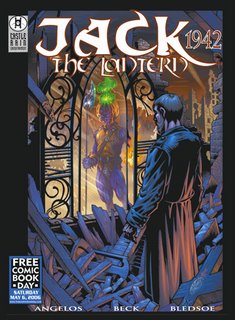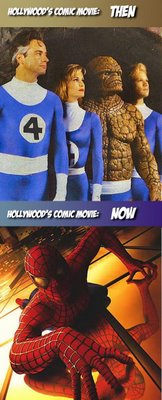I realize as I write this post that I’m being counter productive. The new understanding of the comics that I intend to present could be seriously hindered by these "picks" I’m presenting. While everyone has favorite aspects about anything they enjoy, I find that my "picks" post barely scratches the surface of comic books and detracts from the serious, relevant discussion I intend to engage. This having been said, I will, after this week, be radically reformatting these posts so that we may delve deeper into the possibilities of the comic art medium.
For this week, however, we will have one last comic geek hurrah. The truth is, to the uninitiated, your general fan boy (or girl) loves an inside joke and revels in comic trivia. The more obscure the reference, the harder we laugh… and the further freakish stigmatism outsiders attribute to comic geek-ness. I’m afraid I can’t hold back the inside jokes this week, but I will do my best to let you in on the joke.
Top Pick: Amazing Spiderman #528 (Marvel Comics)
To begin with, Amazing Spiderman #528 is the final chapter of The Spider-Man: the Other event. This event simply is the future of Spider-Man.
Spider-Man is perhaps the most accessible off all heroes; Peter Parker is a fragile-hearted every-man with an indomitable will, gifted with amazing powers and burdened with self-imposed world-crushing responsibility. Any good Spider-Man story, as does Amazing Spiderman #528, offers a near-perfect blend of humor, pathos and adventure.
Page three of Amazing Spiderman #528 has an excellent moment that employs a subtlety that is typically obscured in the medium of comics. Three identical panels, one devoid of dialogue, that allowing the reader to grasp the quite intensity of the scene. While I’ve heard criticism of the use of repeated images as lazy, I appreciate the occasional use of repeated static images. The downside of the unlimited possibility comic storytelling offers is that one might be tempted to lean towards constant movement and the unrelenting excess of visuals at the risk of glossing over the stillness of life. I appreciate beats of silence, stillness and other common subtleties of life when they are recognized by comic creators.
The bottom line is that Spider-Man: the Other is unequivocally the most important development in the history of the character, barring only his inception in Amazing Fantasy #15 (August, 1962), and even if you missed the other eleven chapters of The Other, Amazing Spiderman #528 will fill you in on the most important details. If you don’t find that Amazing Spiderman #528 alone does not answer all your questions, the other key issue for understanding Peter Parkers self-perception, nature and rebirth is Amazing Spider-Man #527, if you can get your hands on it.
Best Lines of Dialogue: Batman #649 (DC Comics)
This is who the Joker is: Bound, beaten bloody, held captive with a knife literally at his throat, and still incensing his aggressor, all for a good laugh.
Joker: Didn’t I kill You? (for "Kill" link scroll to Death in the Family item)
Jason Todd: We’ve been over this already.
Joker: I know, but I like talking about it.
Funniest Moment: Robin #146 (DC Comics)
Robin (III), a.k.a. Tim Drake, is leading three other Teen Titans members through one of Lex Luthor’s secret labs in hopes of finding a cure for fellow Titan Kon-El, the modern Superboy. Robin takes the id signal pods from defeated security droids to keep further droids from identifying the Teen Titans as threats. As another regimen of security droids fie past the quartet unsuspecting, Beast Boy, a.k.a. Garfield Logan, waves his hand and tells the droids, “This is not the titan you were looking for.” Unamused, Cassie Sandsmark, a.k.a. Wonder Girl, says, “Gar, stop bothering the killer robots.”
Although not funny, except in the sickest way, it is ironic that Speedy II, Mia Dearden, asks the others too look for a “speedy fix,” referring to the fact that she is infected with H.I.V, which is unfortunate choice of words for writer Bill Willingham, since the first hero who took that name, Roy Harper, who had been at one time addicted to heroin.
Best Artwork: New Avengers #15 (Marvel Comics)
I’ve been reading Liberty Meadows since it’s syndication in 1997. I knew who Cho was before Wizard Magazine scrambled to explain who Frank Cho was and what Liberty Meadows is when in issue 102, it listed Liberty Meadows #1 as number eight of the top ten Hottest Back issues. The unaccredited author could only question “What the hell is Liberty Meadows?” Frank the monkey boy Cho is a fan boy’s fan boy; better at rendering iconic heroes and idealistic heroines having never officially studied art than many of the Joe Kubert School Alumni.
Best Writer: Revelations #6 (Dark Horse Comics)
Jenkins concludes his this mini-series and finally delivers on all the contradicting evidence and the blessing of lost faith. The conclusion surprised me, no easy feat, especially considering I had figured out the Reveal of DC’s Vigilante #5 by issue three. I found the concept of faith as damnation, or at least an understanding of impending doom as intriguing, even if the case is closer to irrefutable truth and an inability to refuse to believe. Perhaps Detective Charlie Northern explained it best, “I’ve just found out what happens when a man gets given the very thing he thinks he wanted. Not faith. Proof. If you get proof. You lose hope.”
Best Cliffhanger: Green Lantern Corps: Recharge #4 (DC Comics)
Something tells me this book is the unmentioned link in the Infinite Crisis chain of universally disastrous events. Lines have been crossed, truces rescinded, and now Oa’s under fire. Is this once again the end of the Guardians and the Green Lantern Corps, coming so soon after the reforming of the corps? Of course not. That’s just silly. Geoff Johns is writing the series. Batman will get sucker punched for inexplicable reasons, but Hal will swoop in and save the day. What else can you expect from Hal Jordan’s biggest fan?
Best New Series: Next Wave #1 (Marvel Comics)
I almost didn’t buy this book. With as much as I spend on comic books monthly, you don’t want to was it on books you aren’t enjoying. My first clue that this series would not be as trite and boring as a synopsis indicated was the tag line. Even though the encouragement “If you like anything, you will LOVE NEXTWAVE!!!” seemed to beckon the standardless reader, the tongue-in-cheek humor of the slogan “healing America by beating people up,” indicated otherwise. Further confirming the sarcastic spoof was worth $2.99 was Dirk Anger’s speech to his new recruits.
“I’m Dirk Anger, director of H.A.T.E. I’ve been director of H.A.T.E. for longer than you’ve been alive. Except maybe you. You look old…
“I’m older’n you. I’m ninety years old. You know how I look so pretty? I take drugs. Special H.A.T.E. drugs. Life-extending drugs. H.A.T.E. has the best drugs. Because H.A.T.E. loves me. And I love H.A.T.E. Every day of my horrible drug extended terrorist fighting life.
“Everyday I smoke two hundred cigarettes and one hundred cigars and drink a bottle of whisky and three bottles of wine with dinner.
“And dinner is meat...raw meat. The cook serves me an entire animal and I fight it bare-handed and tear off what I want and eat it and have the rest buried. In New Jersey! For H.A.T.E.!”
As icing on the cake, not four panels later, when Anger is called away to a communications room and request that the “etheric loop Recall Televocometer” be deployed, a giant telephone receiver descends from the ceiling above him a la the cone of silence.
Back Issue: Polly and the Pirates #3 (Oni Press)
I like the concepts that Ted Naifeh offered, but have hard a hard time recommending the book to others. The pace is painstakingly slow and redundant at times. Issue three is a good place to start, giving you most of the pertinent information and begins to pick up the pace, although one might prefer to wait for issue four.








